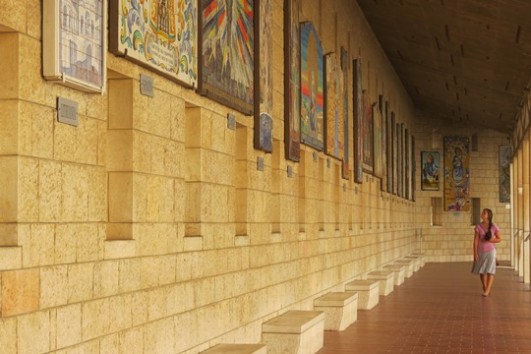If the heart of Nazareth is sacred, its outskirts are very much the opposite. If anything, they provide a perfect example of a system that stubbornly preserves a hierarchy of communities: Arabs below, Jews on top. The third stop on the reconstructed tourist trail.
There is a painting by an Italian master, the great Pierro della Francesca, called “Madonna del Parto.” Two angels hold up the folds of a tent in which Mary stands. She is pregnant, wearing a blue gown with a crack in it, just where her belly pokes out the furthest, allowing for a white undergarment to show through.
The eye, when looking at this painting, follows a carefully crafted trail. It first sees the white cloth at the heart of the matter, then moves out to the outskirts, discovers the tent and the angels, and then begins its journey back inwards, to the very center of the painting, to the hint of things to come, to the soon-to-be born son of God.
There is a church by the eccentric 20th century Italian architect Giovanni Muzio. It stands in the middle of the city of Nazareth, and is the only thing most tourist see of the town. The church is concentric. The bottom level of this massive 20th century concrete monster is a large empty space, centered on the grotto of the annunciation and the ruins of three earlier churches that once stood on this site. On the top floor a large hole gapes over that same central point. This is where all eyes are drawn.
Comparing the Madonna del Parto with the Basiliaca of Annunciation would be an injustice to both. I wouldn’t dream of doing that. Instead, I am comparing the Madonna del Parto with all of Nazareth. When architecture says “Look this way!” it’s a good idea to oblige before looking another way, then looking that way again. The same applies to touristic conventions point anywhere. With your permission, I will explore Nazareth and its church today following the pattern designed by Pierro: Starting from the white glimpse of divine motherhood, moving on to the outskirts, and then moving back in.
City on a hill
In the middle, then, is a large black cone, towering over the site in which a unique encounter between divinity and humanity is said to have taken place. Muzio, who designed the basilica in the 1950s, is just short of being notorious. His most famous building besides this one is a Milanese office building known as “Ca’ Brutta” – i.e. the “ugly house.” He infused the basilica with symbolism; bas reliefs that represent the four elements stretch along the façade, beneath more bas reliefs that represent the four Apostles. Repeating triangles are meant to recall the A and M of Ave Maria. The entire cryptic code would take days to explore, but as promised, we are looking outwards.
Nazareth is situated in a natural bowl, a crater of sorts, encircled by Galilean hills. It is rimmed by another city – “Nazareth Illit” or “Upper Nazareth,” a town conceived at the same time as the church. Nazareth Illit is a serpentine. It winds around central Nazareth and its northern neighborhoods, yet it is not a suburb per se, as it was designed to serve a different ethnicity.
Historical Nazareth is a mixed Muslim and Christian community. Its residents are Palestinian citizens of Israel. Nazareth Illit, meanwhile, was conceived as a Jewish town to counterbalance the Arab one. The towns strategic vantage point, overlooking an Arab town that developed around a lower-altitude spring, recalls the layout of West Bank settlements.
While Nazareth Illit, an industrial town first populated largely by Mizrahi Jews and later by Russian immigrants, is hardly Israel’s answer to Beverly Hills. Nevertheless, it enjoys far better services than Nazareth proper. Up on top there are parks, sidewalks, good education and medical services. Down below, there is hardly any of this. All government functions are situated on the hills, with the monumental regional courthouse overlooking Arab Nazareth from above, in the fashion of Kafka’s “Castle.” The current mayor of Nazareth Illit, unhappy about Arab Nazarenes moving to his more attractive town, has launched various openly racist campaigns against them.
If the heart of Nazareth is sacred, its outskirts are very much the opposite. There is nothing wrong with Nazareth Illit’s residents, and their town truly is a nice place, despite its awkward sprawl around the Arab city. It does, however, provide an example of a problematic system – one that stubbornly preserves a hierarchy of communities: Arabs below, Jews on top. This hierarchy extends further, keeping the Mizrahim, Russians, Ethiopian Jews and others from soaring further, into the well-guarded enclaves of Ashkenazi society.
Mission of Burma
The outlaying neighborhoods of Arab Nazareth are a joy. Nazareth is a culinary powerhouse most famed for its sweets, and here is where the secret pastry shops are to be found. Everyone knows baklavas, but I prefer the dark crispy burmas (rolls of baked kadaif noodles stuffed with sugared nuts). I start my day by shopping for a few of these, but not too many. It would be a horrid mistake to kill one’s appetite before lunch in a city that boasts some of the best restaurants in the country, from the famous Diana, which offers an exquisite take on the traditional Palestinian grill, to that secret place where they sell you shrimp in a pita pocket.
Stop. Here I am, the Jewish-Israeli, experiencing a Palestinian city as a mere restaurant. I know Nazareth well enough to identify it as a cultural and political powerhouse. My first exploration of the city came in 2006, when I wrote an article about its bohemian life. Nazareth had a great art house operated by the Israeli Communist Party, ever powerful in the urban Galilee, a good literary circle, a theatre (closed since), and an “author’s house” which combines a library and an art gallery. It was, and still is, yearning for the one establishment that stirs the artistic and intellectual life and keeps a city young: a university. Alas, the Israeli government again and again votes down this initiative.
As the circle narrows into the downtown, the city’s unique religious history is already apparent. The Latin Basilica is hardly the only church worth exploring here. In fact, it isn’t even the only church of the annunciation. The Eastern Churches recognize a different site, where the Greek Orthodox church of St. Gabrial stands. The waters of Mary’s spring, Nazareth’s original source of water, flow at the far end of its nave.
No less lovely is the chapel of Mensa Christy, a small structure roofing a massive rock. Tradition has it that Jesus and his disciples used this rock as a table while picnicking on the hillside. My guess is that it was held sacred long before the most famous Nazarene was born, perhaps before the birth of Judaism. Of all the tourists that visit Nazareth, about 0.001 percent enter the chapel, its petite interior dominated by mystery, the massive key that for years one had to borrow from the neighbors (it is now kept at the basilica). The rest see only the center. That hole in the ground.
This is not a city to be bussed into and out of. It’s a city that deserves at least one night. I am writing this on the breezy balcony of the Fauzi Azar Inn, a guesthouse with an extraordinary story, born of an unlikely cooperation between a Jewish Israeli entrepreneur and a Palestinian woman. In the kitchen behind me, surrounded by huge jars of dried herbs for the guests to brew tea with, sits a German woman who cannot believe that she is leaving tomorrow. She is headed for Jerusalem.
The cloister
Then, as close as one can get, hugging the basilica in the same way a mother’s arm embraces a tender baby, is the most wonderful place in town. It is the cloister enclosing the church’s yard, and it is full of art. Catholic communities around the world sent basilica mosaics and painted tiles depicting the Madonna and child. Each creation reflects something of the culture and essence of its origin. The Irish Madonna is standing in a moor, an Irish church behind her. The Thai Madonna wears a Siamese crown, her shoulder is exposed.
There are more tiles inside the church, along the walls of the second floor. The Japanese Madonna’s shawl is made of real pearls. An image from Benin transcends all familiar notions of the repeated theme. For many people around the world, the first association to the idea of the event commemorated by this church is art. From Fra Angelico to Leonardo da Vinci, the greats loved to paint the angel’s arrival at Joseph and Mary’s home. Today, in the heart of Nazareth, and despite all faults of the building, art is triumphant. It is art that says the final word. Art holds ajar the flaps of the tent, allowing us to look in both directions.
Read parts one, two and three of Yuval Ben-Ami’s series, “The Beaten Path.”




